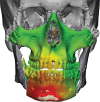Computerized Approach to Facial Transplantation: Evolution and Application in 3 Consecutive Face Transplants
- PMID: 31592022
- PMCID: PMC6756666
- DOI: 10.1097/GOX.0000000000002379
Computerized Approach to Facial Transplantation: Evolution and Application in 3 Consecutive Face Transplants
Abstract
Face transplant (FT) candidates present with unique anatomic and functional defects unsuitable for autologous reconstruction, making the accurate design and transplantation of patient-specific allografts particularly challenging. In this case series, we present our computerized surgical planning (CSP) protocol for FT.
Methods: CSP, computer-aided design and manufacturing, intraoperative navigation, and intraoperative computerized tomography have been successfully incorporated into a comprehensive protocol. Three consecutive FTs were performed. CSP and postoperative results were compared using computerized tomography-derived cephalometric measurements, and the literature was reviewed.
Results: Two full and 1 partial FT were successfully performed using the CSP protocol. CSP facilitated the execution of FT with minor angular and translational cephalometric variations on immediate postoperative imaging. Our evolving experience was accompanied by a decreased reliance on cadaveric simulation, from 10 mock transplants and a research procurement before the senior author's first clinical FT (2012) to 6 mock transplants and no research procurement before the third FT (2018). Operative time was significantly reduced from 36 to 25 hours, as was the need for major orthognathic surgical revision. This reflects the learning curve and variable case complexity, but it is also representative of improved planning and execution, complemented by the systematic incorporation of CSP into FT.
Conclusions: A CSP protocol allows for refinement of operative flow, technique, and outcomes in partial and full FT. Standards for functional and esthetic outcomes are bound to evolve with the field's growth, and computerized planning and execution offer a reproducible approach to FT through objective quality assurance.
Copyright © 2019 The Authors. Published by Wolters Kluwer Health, Inc. on behalf of The American Society of Plastic Surgeons.
Figures









Similar articles
-
Computerized Surgical Planning in Face Transplantation.Semin Plast Surg. 2024 May 27;38(3):242-252. doi: 10.1055/s-0044-1786991. eCollection 2024 Aug. Semin Plast Surg. 2024. PMID: 39118859 Free PMC article. Review.
-
Enhancing Face Transplant Outcomes: Fundamental Principles of Facial Allograft Revision.Plast Reconstr Surg Glob Open. 2020 Aug 17;8(8):e2949. doi: 10.1097/GOX.0000000000002949. eCollection 2020 Aug. Plast Reconstr Surg Glob Open. 2020. PMID: 32983759 Free PMC article.
-
Development and refinement of computer-assisted planning and execution system for use in face-jaw-teeth transplantation to improve skeletal and dento-occlusal outcomes.Curr Opin Organ Transplant. 2016 Oct;21(5):523-9. doi: 10.1097/MOT.0000000000000350. Curr Opin Organ Transplant. 2016. PMID: 27517508 Free PMC article. Review.
-
Total Face, Eyelids, Ears, Scalp, and Skeletal Subunit Transplant Cadaver Simulation: The Culmination of Aesthetic, Craniofacial, and Microsurgery Principles.Plast Reconstr Surg. 2016 May;137(5):1569-1581. doi: 10.1097/PRS.0000000000002122. Plast Reconstr Surg. 2016. PMID: 27119930
-
Optimizing Hybrid Occlusion in Face-Jaw-Teeth Transplantation: A Preliminary Assessment of Real-Time Cephalometry as Part of the Computer-Assisted Planning and Execution Workstation for Craniomaxillofacial Surgery.Plast Reconstr Surg. 2015 Aug;136(2):350-362. doi: 10.1097/PRS.0000000000001455. Plast Reconstr Surg. 2015. PMID: 26218382 Free PMC article.
Cited by
-
Re-cognizing the new self: The neurocognitive plasticity of self-processing following facial transplantation.Proc Natl Acad Sci U S A. 2023 Apr 4;120(14):e2211966120. doi: 10.1073/pnas.2211966120. Epub 2023 Mar 27. Proc Natl Acad Sci U S A. 2023. PMID: 36972456 Free PMC article.
-
Anesthetic Considerations in Facial Transplantation: Experience at NYU Langone Health and Systematic Review.Plast Reconstr Surg Glob Open. 2020 Aug 17;8(8):e2955. doi: 10.1097/GOX.0000000000002955. eCollection 2020 Aug. Plast Reconstr Surg Glob Open. 2020. PMID: 32983760 Free PMC article.
-
Face Transplant: Indications, Outcomes, and Ethical Issues-Where Do We Stand?J Clin Med. 2022 Sep 28;11(19):5750. doi: 10.3390/jcm11195750. J Clin Med. 2022. PMID: 36233619 Free PMC article. Review.
-
Validating a Novel Device to Improve Skin Color Matching for Face Transplants.Plast Reconstr Surg Glob Open. 2022 Nov 18;10(11):e4649. doi: 10.1097/GOX.0000000000004649. eCollection 2022 Nov. Plast Reconstr Surg Glob Open. 2022. PMID: 36415618 Free PMC article.
-
Computerized Surgical Planning in Face Transplantation.Semin Plast Surg. 2024 May 27;38(3):242-252. doi: 10.1055/s-0044-1786991. eCollection 2024 Aug. Semin Plast Surg. 2024. PMID: 39118859 Free PMC article. Review.
References
-
- Rifkin WJ, David JA, Plana NM, et al. Achievements and challenges in facial transplantation. Ann Surg. 2018;268:260–270. - PubMed
-
- Mohan R, Borsuk DE, Dorafshar AH, et al. Aesthetic and functional facial transplantation: a classification system and treatment algorithm. Plast Reconstr Surg. 2014;133:386–397. - PubMed
-
- Lantieri L, Grimbert P, Ortonne N, et al. Face transplant: long-term follow-up and results of a prospective open study. Lancet. 2016;388:1398–1407. - PubMed
-
- Dorafshar AH, Brazio PS, Mundinger GS, Mohan R, Brown EN, Rodriguez ED. Found in space: computer-assisted orthognathic alignment of a total face allograft in six degrees of freedom. J Oral Maxillofac Surg. 2014;72:1788–1800. - PubMed
-
- Dorafshar AH, Bojovic B, Christy MR, et al. Total face, double jaw, and tongue transplantation: an evolutionary concept. Plast Reconstr Surg. 2013;131:241–251. - PubMed
LinkOut - more resources
Full Text Sources
